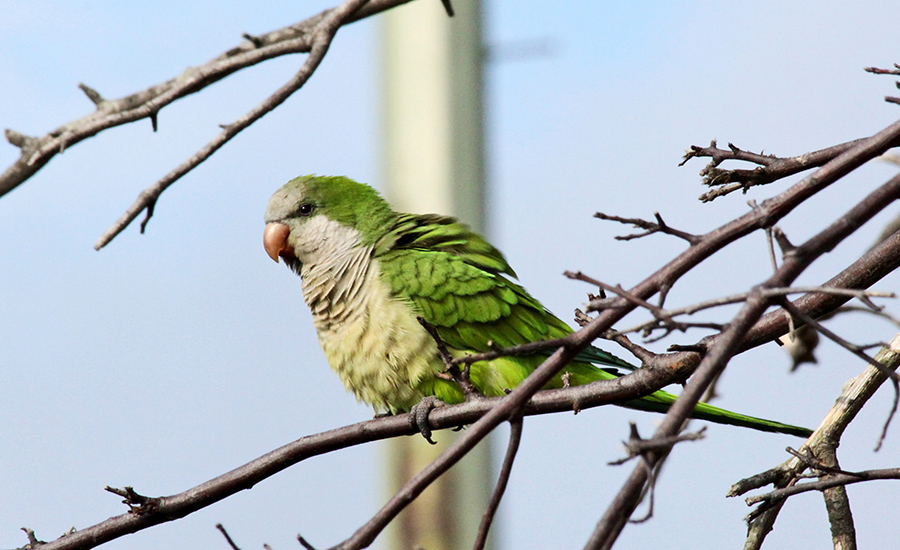
NEW YORK CITY – As temperatures drop and the days shorten, one immigrant group from the Southern Hemisphere doesn’t seem to mind conditions here. Surrounded by ducks, geese and other winter weather birds, the lime green and gregarious monk parakeets seem out of place in the greying, late fall sky. That is, if you notice them at all.
Though the ranges of many parrot species have shrunk in the last century, the South American monk parakeet, also known as the Quaker parakeet, has made enormous advances in territory throughout the globe, including in the New York metro area. Despite dispersing through the exotic pet trade that grew in the 1970s, the birds have generally stayed off New Yorkers’ radar, unlike various other non-native species in the area. Unless a noisy colony of parakeets has taken up residence near your home, the birds can be hard to spot.
Nancy Tognan, vice president of the Queens Bird Club, said she finds that while more people are aware of the birds than in years past, many still are blind to their existence.
“I’ll be out with my camera and my binoculars, and people will come up to me and ask, ‘What are you looking at?’” said Tognan.
Introduced species can cause havoc, often out-competing native species and throwing resources out of balance. However, monk parakeets have found a place in New York without those issues. The cold-tolerant, opportunistic eaters feed from backyard bird feeders while generally keeping to themselves. Most parrots are cavity nesters, making nests out of holes in trees. Monk parakeets are the only parrots to build their own nests out of sticks.
Kevin Burgio, a doctoral candidate at the University of Connecticut who studies monk parakeets, said the birds’ tendency to noisily build messy nests on electrical lines and lampposts is the only cause for public inconvenience from these birds. This downside of the birds’ expansion in New York may become a thing of the past with research performed by Burgio and others at the university. They found that by blocking the rebuilding of nests on power lines at the beginning, the municipality could save thousands of dollars in nest removal costs, spare lethal measures against the birds and avoid fires and electricity outages. They hope to improve conditions for the parakeets in the near future.
Monk parakeets live in areas from New England to the Pacific Northwest in the United States, and there are populations in Europe and the Middle East. Concentrated in urban areas, the separate populations have grown slowly, according to the Cornell Lab of Ornithology.
Mark Morrone, bird expert and owner of Parrots of the World in Rockville Centre, New York, says that the general consensus is that the populations grew over time from pets being intentionally and non-intentionally released.
“There’s a story about a crate coming off a truck at John F. Kennedy [International Airport] and they all flocked out,” Morrone said. “[It’s] dramatic, but it’s just not true.”
Unlike other parrot species, the monk parakeet has evolved in ways that are improving its range, while so many other species are in decline, according to Burgio.
In their native South American range, they have developed traits to withstand cold temperatures, such as lowering their metabolic rates at night, an effect less extreme than, but similar to, a bear’s hibernation.
While these little parrots have succeeded due to their adaptations and lack of major human interference that other species experience, some believe that the extinction of the Carolina parakeet, the once-native parrot species, created a perfect hole in the ecosystem for the monk parakeets. But, according to Burgio and new research expected to be published within the next year, the species are different enough in their traits and behavior that this could not have positively affected the monk parakeets.
“I don’t really think the reason they’re here is because one parrot species went extinct,” Burgio said. “Just because they’re parrots and they live in kind of the same part of the world, I don’t think that necessarily makes one the equivalent of the other.”
As monk parakeets remain a top pet globally and their wild populations continue to grow, there seems to be a happy future for this true parrot of the world.
